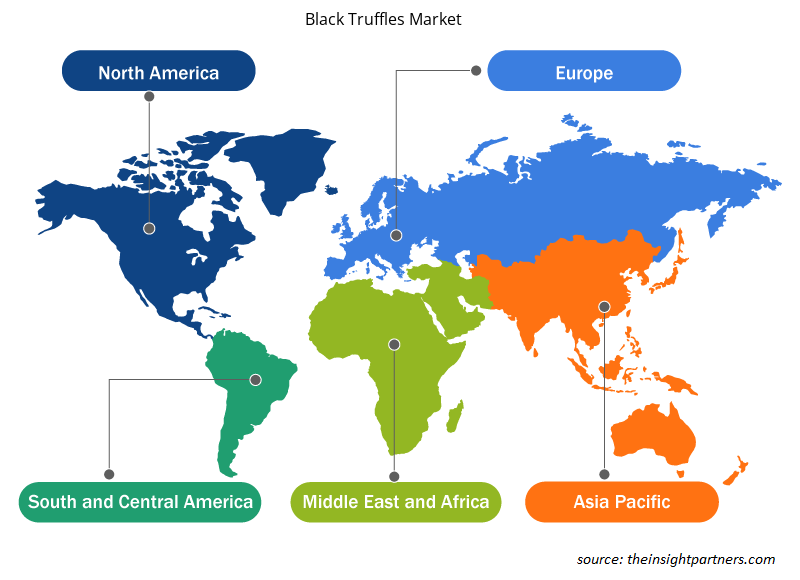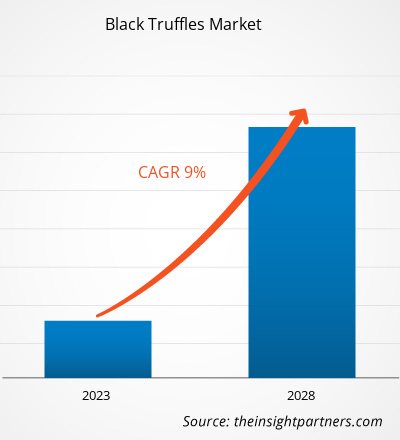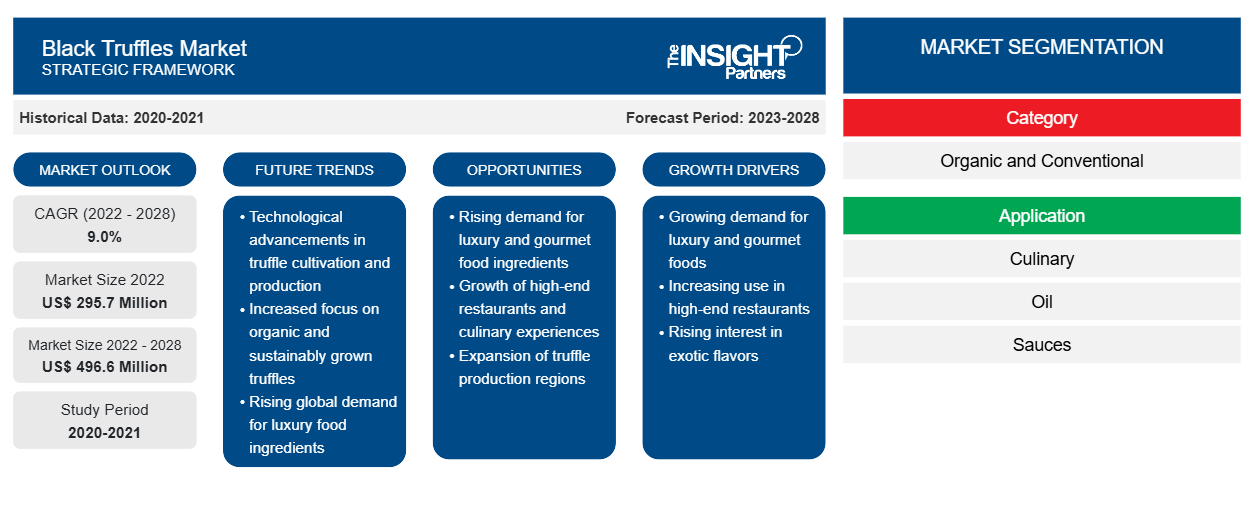من المتوقع أن ينمو حجم سوق الكمأة السوداء من 295.7 مليون دولار أمريكي في عام 2022 إلى 496.6 مليون دولار أمريكي بحلول عام 2028؛ ومن المتوقع أن ينمو بمعدل نمو سنوي مركب قدره 9.0٪ من عام 2022 إلى عام 2028.
الكمأة السوداء (Tuber melanosporum)، والمعروفة أيضًا باسم كمأة بيريجورد أو كمأة الشتاء السوداء، توجد في البرية في جميع أنحاء أوروبا من نوفمبر إلى فبراير، على الرغم من أن الموسم يمكن أن يختلف قليلاً. في الآونة الأخيرة، تمت زراعة الكمأة السوداء الشتوية بنجاح في أستراليا ونيوزيلندا. الكمأة السوداء هي فطريات خارجية، لذلك توجد عادةً في ارتباط وثيق بجذور الأشجار. تُستخدم الكمأة السوداء بشكل رئيسي في المطبخ الإيطالي والفرنسي. تتمتع الكمأة السوداء بنكهات وروائح فريدة. طعم الكمأة السوداء له نكهات ترابية مع لمحة من النعناع والفلفل والبندق. يفضل العديد من الذواقة الكمأة السوداء بسبب نكهتها الفريدة. غالبًا ما يطلق الطهاة على الكمأة السوداء "ماسة المطبخ".
تأثير جائحة كوفيد-19 على سوق الكمأة السوداء
في عام 2020، اضطرت العديد من الصناعات إلى إبطاء عملياتها بسبب الاضطرابات في سلاسل القيمة والتوريد الناجمة عن إغلاق الحدود الوطنية والدولية. أثرت جائحة كوفيد-19 سلبًا على الاقتصادات والصناعات بسبب عمليات الإغلاق وحظر السفر وإغلاق الأعمال. كان للاضطرابات في سلاسل توريد المواد الخام الرئيسية والمخالفات في عمليات التصنيع بسبب القيود التي فرضتها السلطات الحكومية تأثير مباشر على صناعة الأغذية والمشروبات. أثرت هذه العوامل سلبًا على سوق الكمأة السوداء خلال جائحة كوفيد-19. ومع ذلك، في عام 2021، شهد السوق انتعاشًا إيجابيًا حيث أعلنت الحكومات عن تخفيف القيود المفروضة سابقًا. سُمح للمصنعين بالعمل بكامل طاقتهم، والاستفادة من ربحيتهم. ومن المتوقع أن يحرك هذا العامل السوق في السنوات القادمة.
قم بتخصيص هذا التقرير ليناسب متطلباتك
ستحصل على تخصيص لأي تقرير - مجانًا - بما في ذلك أجزاء من هذا التقرير، أو تحليل على مستوى الدولة، وحزمة بيانات Excel، بالإضافة إلى الاستفادة من العروض والخصومات الرائعة للشركات الناشئة والجامعات
-
احصل على أهم اتجاهات السوق الرئيسية لهذا التقرير.ستتضمن هذه العينة المجانية تحليلاً للبيانات، بدءًا من اتجاهات السوق وحتى التقديرات والتوقعات.
رؤى السوق
مبادرات ابتكار المنتجات من قبل المستخدمين النهائيين
يستثمر مصنعو الكمأة السوداء بشكل كبير في البحث والتطوير والشراكات والتعاون لإطلاق منتجات مبتكرة لجذب قاعدة كبيرة من المستهلكين. يطلق بائعو الأطعمة والمشروبات منتجات جديدة تعتمد على الكمأة، مثل الصلصات والزيوت، مما يؤدي إلى استهلاك الكمأة السوداء في السوق العالمية. في عام 2018، أطلقت شركة deRosario، وهي شركة تصنيع مقرها الولايات المتحدة، مجموعة من توابل الكمأة المصنوعة من الكمأة، بما في ذلك زيت الكمأة السوداء وزيت الزيتون البكر الممتاز. في عام 2020، أطلقت شركة PS Gourmet Pe زيت الكمأة السوداء في سنغافورة. في نوفمبر 2022، دخلت شركة TRUFF، وهي شركة تصنيع مقرها أستراليا، مجال التوابل بـ "ملح الكمأة السوداء TRUFF". يتميز خيار التوابل بمزيج من ملح البحر الناعم والخشن مع كمية مستهدفة من الكمأة السوداء. تساعد مثل هذه المنتجات التي يتم إطلاقها الشركات على إقامة علاقات طويلة الأمد مع المستهلكين النهائيين.
رؤى النوع
بناءً على الفئة، يتم تقسيم سوق الكمأة السوداء إلى عضوي وتقليدي. ومن المتوقع أن يسجل القطاع العضوي معدل نمو سنوي مركب أعلى خلال فترة التنبؤ. تُزرع الكمأة السوداء العضوية في تربة خالية من الأسمدة الكيماوية (مثل النيتروجين الصناعي والفوسفات والبوتاس) والمكونات المعدلة وراثيًا. كما يتم تجنب مبيدات الأعشاب والمبيدات الحشرية الاصطناعية في زراعة الكمأة السوداء العضوية. بدلاً من ذلك، يستخدم المزارعون محفزات النمو العضوية لزراعة الكمأة السوداء العضوية. بشكل عام، تكون الكمأة السوداء العضوية أكثر تكلفة من الكمأة التقليدية بسبب جودتها العالية. تركز الشركات على تحقيق شهادات العضوية لتلبية الطلب المتزايد على الكمأة السوداء العضوية في السوق.
رؤى التطبيق
بناءً على التطبيق، يتم تقسيم سوق الكمأة السوداء إلى الطهي؛ والزيت؛ والصلصات، والدهون، والزبدة؛ وغيرها. احتل قطاع الطهي أكبر حصة من السوق في عام 2021. يتم مبشورة الكمأة السوداء في الصلصات القائمة على النبيذ أو الكريمة أو مبشورة على المعكرونة المطبوخة أو البيض المخفوق أو أطباق البطاطس. تضاف الكمأة السوداء كإضافات إلى العديد من المنتجات الغذائية لتحسين نكهتها ومنحها مظهرًا أكثر فخامة. علاوة على ذلك، تضاف الكمأة السوداء كمكونات لتزيين وجبات اللحوم ولإضفاء نكهة قوية على الطعام. كما يتم استخدامها لإنتاج ملح الكمأة وعسل الكمأة. تحتوي بعض أنواع الجبن المتخصصة على الكمأة السوداء أيضًا. تعمل هذه العوامل على تغذية الطلب على الكمأة السوداء في التطبيقات الطهوية.
تشمل الجهات الفاعلة الرئيسية العاملة في سوق الكمأة السوداء Trufo وTRUFFUS SAS وL'Aragonais Food Supplies SL وSABATINO NA LLC وLAUMONT TRUFFLES SLU وArotz SA وLes Freres Jaumard SaRL وPerigord Truffles of Tasmania Pty Ltd وGreat Southern Truffles Pty Ltd وOld World Truffles. تركز هذه الجهات الفاعلة على توفير منتجات عالية الجودة لتلبية متطلبات العملاء. كما تركز على استراتيجيات مثل الاستثمارات في أنشطة البحث والتطوير وإطلاق منتجات جديدة.
نظرة إقليمية على سوق الكمأة السوداء
لقد قام المحللون في Insight Partners بشرح الاتجاهات والعوامل الإقليمية المؤثرة على سوق الكمأة السوداء طوال فترة التوقعات بشكل شامل. يناقش هذا القسم أيضًا قطاعات سوق الكمأة السوداء والجغرافيا في جميع أنحاء أمريكا الشمالية وأوروبا ومنطقة آسيا والمحيط الهادئ والشرق الأوسط وأفريقيا وأمريكا الجنوبية والوسطى.

- احصل على البيانات الإقليمية المحددة لسوق الكمأة السوداء
نطاق تقرير سوق الكمأة السوداء
| سمة التقرير | تفاصيل |
|---|---|
| حجم السوق في عام 2022 | 295.7 مليون دولار أمريكي |
| حجم السوق بحلول عام 2028 | 496.6 مليون دولار أمريكي |
| معدل النمو السنوي المركب العالمي (2022 - 2028) | 9.0% |
| البيانات التاريخية | 2020-2021 |
| فترة التنبؤ | 2023-2028 |
| القطاعات المغطاة |
حسب الفئة
|
| المناطق والدول المغطاة |
أمريكا الشمالية
|
| قادة السوق وملفات تعريف الشركات الرئيسية |
|
كثافة اللاعبين في سوق الكمأة السوداء: فهم تأثيرها على ديناميكيات الأعمال
يشهد سوق الكمأة السوداء نموًا سريعًا، مدفوعًا بالطلب المتزايد من جانب المستخدم النهائي بسبب عوامل مثل تفضيلات المستهلكين المتطورة والتقدم التكنولوجي والوعي المتزايد بفوائد المنتج. ومع ارتفاع الطلب، تعمل الشركات على توسيع عروضها والابتكار لتلبية احتياجات المستهلكين والاستفادة من الاتجاهات الناشئة، مما يؤدي إلى زيادة نمو السوق.
تشير كثافة اللاعبين في السوق إلى توزيع الشركات أو المؤسسات العاملة في سوق أو صناعة معينة. وهي تشير إلى عدد المنافسين (اللاعبين في السوق) الموجودين في مساحة سوق معينة نسبة إلى حجمها أو قيمتها السوقية الإجمالية.
الشركات الرئيسية العاملة في سوق الكمأة السوداء هي:
- تروفو، تروفوس إس إيه إس
- شركة لاراجونيه لتوريد المواد الغذائية
- شركة ساباتينو نا المحدودة
- حلوى ترافل لومونت SLU
- شركة اروتز
إخلاء المسؤولية : الشركات المذكورة أعلاه ليست مرتبة بأي ترتيب معين.

- احصل على نظرة عامة على أهم اللاعبين الرئيسيين في سوق الكمأة السوداء
تقرير يسلط الضوء على
- اتجاهات الصناعة التقدمية في سوق الكمأة السوداء لمساعدة اللاعبين على تطوير استراتيجيات فعالة طويلة الأجل
- استراتيجيات نمو الأعمال التي تتبناها الشركات لضمان النمو في الأسواق المتقدمة والنامية
- تحليل كمي لسوق الكمأة السوداء من 2019 إلى 2028
- تقدير الطلب العالمي على الكمأة السوداء
- تحليل القوى الخمس لبورتر لتوضيح فعالية المشترين والموردين للكمأة السوداء
- التطورات الأخيرة لفهم سيناريو السوق التنافسي
- اتجاه السوق وتوقعاته، إلى جانب العوامل التي تدفع وتكبح نمو سوق الكمأة السوداء
- المساعدة في عملية اتخاذ القرار من خلال تسليط الضوء على استراتيجيات السوق التي تدعم المصلحة التجارية
- حجم سوق الكمأة السوداء في مختلف العقد
- نظرة عامة مفصلة وتقسيم السوق، بالإضافة إلى ديناميكيات صناعة الأغذية والمشروبات
- حجم سوق الكمأة السوداء في مختلف المناطق مع فرص نمو واعدة
نبذة عن الشركة
- تروفو
- ترفوس ساس
- شركة لاراجونيه لتوريد المواد الغذائية
- شركة ساباتينو المحدودة
- حلوى ترافلز لومونت
- شركة اروتز
- شركة الأخوة جومارد
- كمأة بيريجورد في تسمانيا المحدودة
- شركة جريت ساوثرن ترافلز المحدودة
- الكمأة من العالم القديم
- التحليل التاريخي (سنتان)، سنة الأساس، التوقعات (7 سنوات) مع معدل النمو السنوي المركب
- تحليل PEST و SWOT
- حجم السوق والقيمة / الحجم - عالمي، إقليمي، بلد
- الصناعة والمنافسة
- مجموعة بيانات إكسل
التقارير الحديثة
شهادات العملاء
سبب الشراء
- اتخاذ قرارات مدروسة
- فهم ديناميكيات السوق
- تحليل المنافسة
- رؤى العملاء
- توقعات السوق
- تخفيف المخاطر
- التخطيط الاستراتيجي
- مبررات الاستثمار
- تحديد الأسواق الناشئة
- تحسين استراتيجيات التسويق
- تعزيز الكفاءة التشغيلية
- مواكبة التوجهات التنظيمية























 احصل على عينة مجانية ل - سوق الكمأة السوداء
احصل على عينة مجانية ل - سوق الكمأة السوداء